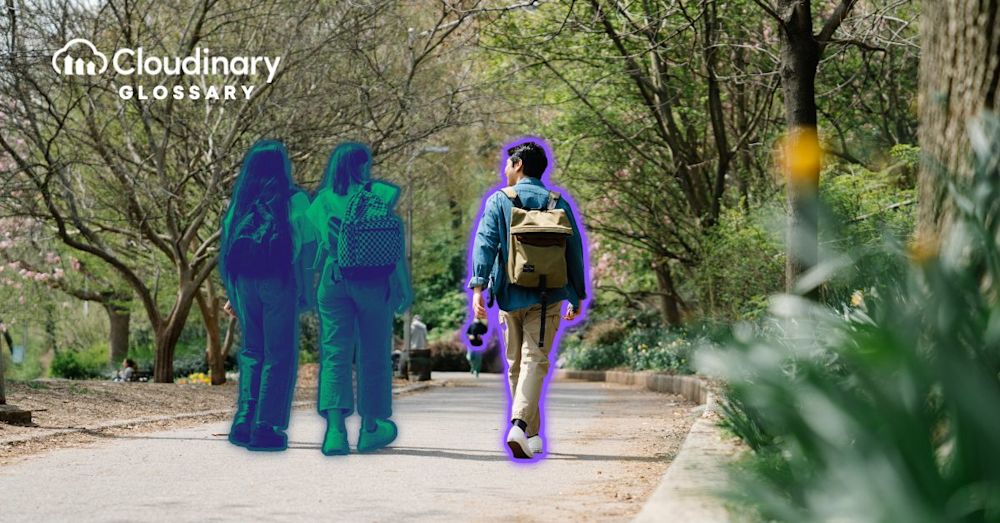What is Image Segmentation?
Image segmentation is a vital process in computer vision, a sub-domain of AI that seeks to give machines the power to interpret and understand visual inputs. Essentially, image segmentation is the act of partitioning an image into multiple sections, known as ‘segments,’ to simplify the image or to make it easier to analyze. Just as we divide a complex problem into more manageable parts, image segmentation breaks down an image into its constituent parts or objects.
Among the various techniques of image segmentation, some key ones include:
- Semantic Segmentation: This method uses a class label to mark all objects of the same type within an image, identifying and classifying regions such as buildings, roads, parks, and water bodies.
- Instance Segmentation: Going a step further, instance segmentation gives separate labels to each distinct instance of an object, even if they are similar, thus detecting and delineating each object individually.
- Panoptic Segmentation: This advanced technique combines the principles of semantic and instance segmentation to predict the identity of each object, providing a comprehensive understanding of the scene.
- Edge Detection: Here, edge detection operators are used to identify areas in the image with a discontinuity in gray levels, color, texture, etc., marking the boundaries of different objects or features.
- Region-based Segmentation: This approach divides the image into sections based on similar features, grouping neighboring pixels based on shared characteristics like color, intensity, or texture.
- Watershed Segmentation: In this method, the image is treated as a topographic relief, where pixel intensities represent the height, helping to segment the image based on these topographic features.
Morphological Operations: These operations, including techniques like erosion and dilation, are used for extracting features and objects from an image, or for cleaning up or smoothing the image.
These segmented parts can be anything from objects, lines, contours, or a collection of pixels with the same characteristics. For example, in a photo of a football match, image segmentation could separate players from the background, divide the crowd into individuals or groups, or even differentiate between different sections of the pitch. It serves as the initial step in many image processing tasks, including object recognition or scene understanding, enabling machines to perceive images with a degree of understanding similar to a human.
What Is Image Segmentation Used For?
Image segmentation is more than just an exciting AI concept — it’s an incredibly practical tool, with applications spanning across a swath of industries and domains. Here are just a few of the areas where image segmentation can bring significant value:
- Medical Imaging. It aids in detailed analysis, like locating tumors, measuring tissue volumes, studying anatomical structure, 3D reconstructions, and more by segmenting different parts of MRI or CT scans.
- Autonomous Vehicles. Autonomous vehicles segment their real-time surroundings into various objects like pedestrians, other vehicles, and road signs, helping in safe decision-making.
- Traffic Control Systems. By distinguishing vehicles from other objects, traffic densities can be tracked and managed more efficiently.
- Computer Vision. It forms the first step in many computer vision tasks such as object detection, facial recognition, image recognition, and more.
- Agriculture. Techniques like crop health monitoring and disease detection use segmentation to identify specific regions of crops or specific types of plants or diseases.
- Augmented Reality. AR uses segmentation for object recognition and interaction, which is crucial for a blended virtual and real-world experience.
These applications are just the tip of the iceberg, and as the field of AI continues to evolve, the possibilities for image segmentation are likely to expand even further.
How Does Image Segmentation Work?
Image segmentation primarily operates through two main methodologies: Contour-based and Region-based techniques. Contour-based techniques work by identifying and connecting points with similar attributes along a continuous boundary, tracing the contours of different objects or features in an image. Take, for example, a cluster of stars against the night sky. This technique would distinguish and map out individual stars based on their contours, effectively dividing the image into segments of stars and the dark sky.
On the other hand, Region-based techniques consider neighboring pixels and group them based on certain shared characteristics such as color, intensity, or texture. Going back to the football match example, this technique could be used to group all green pixels together to identify the grass. Modern image segmentation algorithms perform these tasks using advanced AI, leveraging deep learning models specifically trained for this purpose. The choice between these techniques is determined by the specific requirements of the image processing task at hand.
The Different Types of Image Segmentation
Image segmentation is no one-size-fits-all process. Depending on the specific task and desired outcome, different types of image segmentation can be used. These include:
- Thresholding: This is the simplest form of segmentation, which involves classifying pixels as ‘object’ or ‘background’ based on a chosen intensity threshold.
- Region Growing: Here, the segmentation starts from a seed point and continues to grow by adding neighboring pixels that share similar attributes.
- Clustering: In this method, pixels are grouped together based on their similarities, which can include color, intensity, or texture. Examples include K-means and Gaussian Mixture Model clustering.
- Compression-based methods: These methods aim to simplify the image by reducing the number of colors.
- Edge Detection: This type identifies the edges or boundaries of objects within an image.
- Watershed: Based on image morphology, this method treats pixel intensities as a topographic surface and finds ‘catchment basins’ and ‘watershed ridge lines’ to segment the image.
- Artificial Neural Networks: Deep-learning-based methods such as Convolutional Neural Networks (CNNs) or Fully Convolutional Networks (FCNs) are becoming increasingly popular for image segmentation.
Each method comes with its unique strengths and weaknesses, and the choice ultimately depends on the specific image, computational resources, and desired outcome.
Final Thoughts
In a world where artificial intelligence is reshaping various aspects of our lives, image segmentation stands as a potent tool for making machines ‘see’ and ‘understand’ visual data akin to humans. It’s a powerful approach that often serves as the foundation for many sought-after applications, from medical imaging to autonomous vehicle navigation and more. With an array of techniques, each best-suited to specific types of tasks, image segmentation truly is as versatile as it is essential.
Exploring new technologies and learning new skills can seem challenging, but tools like Cloudinary are here to make it easier. Whether you’re a seasoned professional or a beginner stepping into the world of AI and image processing, Cloudinary offers a swath of features to simplify and enhance your image management strategies. Don’t just stop at understanding – apply your knowledge and experiment, test, and innovate.
Ready to embark on your image segmentation journey? Start with a free Cloudinary account today and unlock the limitless possibilities of intelligent image processing.
Check Out Our Tools That You May Find Useful:



